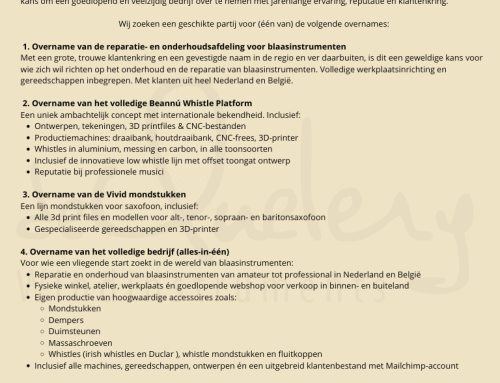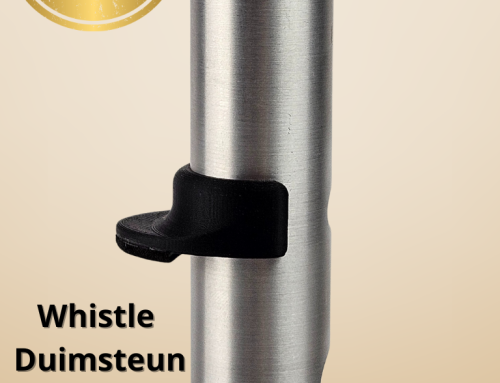You might have heard about 3D-printing of certain parts, like phone cases, desk organizers and toys, or even complete houses and bridges from concrete! You may have seen the trombones, trumpets and saxophones that have been printed. You may have noticed that while these instruments may look nice, thaey simply do not come close to their metal brothers and sisters. Especially when it comes to aking vital parts like valves and other mechanics, plastic is not the ideal material. However, 3D printing of metal is already happening, and developments go fast. Real fast. It will only be a matter of time before the caharacterstics of printed musical instruments will be on par with instruments made from a machined or hand hammered piece of metal.
Let’s leave the possibility of printing instruments for what it is. 3D-printing of music instrument parts however is very interesting; you can design and create a part that is hard to make with a lathe of CNC machine. Also, for parts that are not being made anymore, 3D printing can be a solution. At deQuelery, we have been desinging and printing mouthpieces for a few years now. However, we never felt it was the right time because of the materials used, or because of the design not being perfect. Let’s look at how mouthpieces are made the traditional way; you need a piece of metal, and a handy machine that can do the work in a very precise way.
Have a look at the video below how Lebayle is making their mouthpices, partly by hand.
Why all the interest in 3D printing?
As you can see, a lot of expertise is used to make a mouthpiece. The machines used eat away a lot of material, and you need to be extremely skilled to make a mouthpiece. Also, the machine has its limits in terms of amplitude and internal shapes it can cut away. Even when you have a machine that is completely automated and equipped with the most expensive drills, mills and other tools.
3D printing is very different from milling as with milling you remove material, and with 3D-printing you add material (additive technique).
Another thing that is completely different is that with 3D-printing, you can make shapes that you can’t make with a CNC machine, like cuts and edges.
Design
In addition to this, with 3D-printing the credo is; when you can think about it and design it, you can probably print it! having said this, of course half of the work is the design part; countless hours have been spent on designing, prototyping, testing etc.
Designing a complex part like a mouthpiece requires skill. At deQuelery, we are doing this oursleves, just like the printing and finishing like setting up a facing and the curve of a mouthpiece. Even if you buy a mouthpiece off the shelve from a big company, it can still be useless when facing is not done correctly.
Finishing a part
Just lie with any other mouthpiece, we spend a lot of time finishing the part; we make sure the table is even and crrates a good seal with the reed, we make sure everything is symmetrical. The facing is the most imporant part, especially the start of the curve. This is all manual work. The idea that you can jsut print a mouthpiece and send it off to the customer is an illusion. When you’re interested in buying a 3D-printed mouthpiece, always ask the seller how they do their finishing and what facing or curve they apply. We always try to understand what the customer wants; not the other way around!
Material
The material used for printing is very important. The raw material can be made from nylon, PLA (corn starch), ABS, PETG etc.. Food safety is key; always check what the raw material is and whether it is certified to be used. At deQuelery , we are making use of a special certified engineering PLA made from corn starch.
Adjusting a design to your needs is of course possible. We don’t promise you will sound like your all-time saxophone hero, but we will come close to the sound that you’ve always heard in your head.
Last but not least: ‘why is it called 3D-printing’? We don’t know to be honest, but then again what’s in a name? You know the basics now.
If you’d like to read more about designing and 3D-printing, please read our 3D white paper HERE. (Also available in English).

An example of how you can come to a product with a 3D print and parts of brass. The ligature is printed in 3D and designed by us.

One of our projects is designing and making clarinet barrels.
Are there any disadvantages? Yes, there are. 3D-printing a tenor mouthpiece takes 7 hours. This is just printing time. Another hour is needed to flatten the table, sand down and remove any excess filament and do the facing. Then polishing. In terms of material, we have found an excellent material called HDPLA that is hardened in an oven. This is called annealing. Right now, we have designed mouthpieces that play really well and sound just as good as any other!
Another disadvantage is that while designing the piece, some extra material needs to be added as the mouthpiece will be sanded and polished.
We’ve done some endurance testing, and our PLA holds up fantastically. With materials getting better and better, the charateristics will improve as well. The comment that we hear often is ‘it looks ok but hard rubber or metal is still what I would choose’. Fair enough, after all, 3D printed mouthpieces are made from some sort of plastic, which may give them a cheap appearance. Sure. Until you try them! Many musicians are very conservative and are afraid to try new things. That’s why new developments for the for example, the saxophone, come slowly. There’s lots more to develop and improve!
UPDATE: In the mean time, we started to print our designs with 3D printable resin. Rather than using a filament, we’re using liquid resin that is subjected to light in the printer. Hardening is done with UV light. Result: , more detail, excellent finish, smooth surface inside and -out. This resin is only available in black and grey, but the results are as good as normal resin mouthpieces. More to come, we are in the process of testing our mouthpieces.
And in the years to come, more possibilities in 3D printing will see the light, like printing in metal – which is already happening and progressing fast! We’ll keep you posted!








Leave A Comment